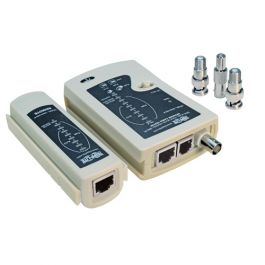Hello Folks,
The previous owners of our house apparently were Dish TV subscribers, and they left behind a VIP722k receiver (with smartcard still inserted) and the rooftop satellite dish. Our CATV RG6U cables are home-runned into a distribution cabinet in my office. The distribution equipment was removed before we got here, and all the cables are hanging in the breeze, but nothing is labeled. Assuming that the wire (or wires) from the satellite dish were brought into this cabinet, can I use a multimeter to identify which wires go to the dish?
In the interim, I have setup a test bench with the VIP722 connected to a TV. I have tried connecting each of the cables, one at a time, to the Sat 1 input. The receiver powers up and gets to the 'acquiring signal' screen, but after a few seconds gives the error code 'Complete signal loss 31-11-45'. Same thing happens when connected to the Sat 2 input.
Should the receiver still be capable of acquiring a signal, even though the service at this location was disconnected over a year ago? I figured, if the correct wire to the dish was connected, that it would find the signal and then tell me to contact DishTV to subscribe (or something like that). My main priority is identifying the wires that go to the dish.
If I was able I would climb on the roof and in the attic to trace the wires, but I am currently confined to the ground because of a broken foot.
Thanks in advance for your assistance and support!
The previous owners of our house apparently were Dish TV subscribers, and they left behind a VIP722k receiver (with smartcard still inserted) and the rooftop satellite dish. Our CATV RG6U cables are home-runned into a distribution cabinet in my office. The distribution equipment was removed before we got here, and all the cables are hanging in the breeze, but nothing is labeled. Assuming that the wire (or wires) from the satellite dish were brought into this cabinet, can I use a multimeter to identify which wires go to the dish?
In the interim, I have setup a test bench with the VIP722 connected to a TV. I have tried connecting each of the cables, one at a time, to the Sat 1 input. The receiver powers up and gets to the 'acquiring signal' screen, but after a few seconds gives the error code 'Complete signal loss 31-11-45'. Same thing happens when connected to the Sat 2 input.
Should the receiver still be capable of acquiring a signal, even though the service at this location was disconnected over a year ago? I figured, if the correct wire to the dish was connected, that it would find the signal and then tell me to contact DishTV to subscribe (or something like that). My main priority is identifying the wires that go to the dish.
If I was able I would climb on the roof and in the attic to trace the wires, but I am currently confined to the ground because of a broken foot.
Thanks in advance for your assistance and support!




